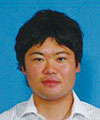 |
|||
|
|
|||
|
Feature Articles: R&D on Maintenance and Management Technologies for Telecommunication Infrastructure Vol. 12, No. 10, pp. 25–30, Oct. 2014. https://doi.org/10.53829/ntr201410fa4 Technology for Highly Efficient and High Quality Diagnosis of Infrastructure FacilitiesAbstractThe large number of infrastructure facilities throughout the country must be regularly inspected and diagnosed for possible problems. The NTT Access Network Service Systems Laboratories is working toward a transition from the current methods involving inspection and diagnosis by humans to automatic methods, which will be essential for carrying out such work efficiently over a wide area. This work involves advancing the existing image processing technology through a fusion of various technologies that include sensor networks, mechatronics, and remote sensing systems that have been developed in other laboratories. This article describes the inspection technology for concrete utility poles and manhole covers as representative of the direction of our most recent research and development. Keywords: infrastructure facilities, non-destructive inspection technology, automatic diagnosis 1. IntroductionNTT performs systematic inspections of all facilities, and most of these inspections are done visually. The inspectors observe the infrastructure facilities (for example, concrete utility poles and manholes) that support telecommunications services to see whether any deterioration (such as degradation of performance over time due to corrosion of steel and neutralization of concrete) or deformation (cracking, warping, distortion, peeling, rust run-off, and other abnormalities that can be seen on the surface) has occurred and to determine the degree and scale of the deterioration. The necessary repair, reinforcement, or renovation is then performed. Also, the large amount of data obtained in the inspections is stored in a database and used as evaluation criteria and as a basis for optimizing and adjusting evaluation methods and operations in the maintenance and management of infrastructure facilities. Through such efforts, we ensure the safety and reliability of the many NTT facilities throughout the country and support stable provision of telecommunication services. Nevertheless, there are problems that must be overcome by introducing new technology for the inspection and diagnosis of infrastructure facilities. These problems include the following:
The NTT Access Network Service Systems Laboratories took these problems into account and focused on the three aspects of cost, quality, and added value in creating new inspection technology. For cost, we targeted inspection methods that involve less work, fewer procedures, and fewer people. For quality, we aimed to develop inspection methods that could be done accurately and uniformly by anyone, anywhere, and at any time, without requiring the skill level of an experienced technician. For added value, our objectives were ease of handling, higher work safety, and visualization techniques for locations where naked-eye inspections are difficult. The research being done at the NTT Access Network Service Systems Laboratories on infrastructure facilities inspection and diagnosis technology is moving forward, with short-to-mid-term work and long-term work being done in parallel. Our short-term to mid-term work puts priority on maintaining safety with respect to inspection of infrastructure facilities (concrete poles, manhole covers, and facilities attached to bridges) in which there is potential for damage or harm to third parties. Specifically, we aim to develop inspection and diagnosis technology that eliminates sites where inspection is difficult or impossible and that reduces the number of sites where high levels of labor, cost, and technical skills are required. Our mid-term to long-term work is aimed at developing innovative inspection and diagnosis technology that achieves a radical change in the maintenance and management of infrastructure facilities through collaboration with other NTT laboratories developing image processing technology and sensor technology to enable screening inspection and continuous monitoring using still and moving images. This article describes the direction of the most recent research on infrastructure facility inspection and diagnosis for concrete poles and manhole covers underway at the NTT Access Network Service Systems Laboratories. 2. Concrete pole inspection and diagnosis technologyNTT EAST and NTT WEST together have about eight million concrete poles throughout Japan, which are inspected periodically to maintain them in a safe condition. In the inspections, the surface is examined for cracks by eyesight or with a binocular microscope. Ultrasound sensors are used for non-destructive inspection of parts that are underground or that are hidden by sheets attached to the poles to prevent the posting of advertisements, and magnetic sensors are used to check the utility pole for internal degradation. An accurate understanding of cracking or internal degradation, however, requires inspectors that have expert knowledge, skill, and proficiency. Recently, the number of proficient technicians available for inspecting concrete poles that are in service has been decreasing, making it difficult to maintain both the quantity and quality of inspections. To address this problem, the NTT Access Network Service Systems Laboratories has been researching three inspection and diagnosis technologies for utility poles. These technologies enable inspections that are even more accurate and efficient than current inspections regardless of the skill and proficiency of the inspector. 2.1 Crack inspection technology based on image analysisThis technology can automatically detect the cracks that arise on the surface of concrete poles from photographic images obtained with commercially available digital cameras (Fig. 1). However, remotely acquired photographs of concrete poles often include cables, foot pegs, and other objects attached to the poles, as well as the area in the background, so the outline edges of those objects may be mistakenly detected as cracks in the image processing. Humans use information such as hue and the feel of a material to recognize cracks on the surface of a concrete pole, so we have implemented a function for automatically removing attached objects and the background from the image by implementing this discrimination task using image processing technology. By doing so, we were able to reduce errors in detection and to accurately detect cracks. This technology can be used to conduct accurate inspections, regardless of worker skill and experience, and it makes it easy to check for the presence of cracks and their location, including on the upper parts of concrete poles, which previously required extensive labor for visual inspection. There is also a function for automatically organizing and managing the large number of acquired images for each utility pole, which greatly reduces the amount of paperwork.
2.2 Technology for detecting cracks beneath protective sheetsCurrently, the detection of cracks hidden behind posting prevention sheets and other obstacles is done with detection equipment that uses ultrasound. However, some expertise is required to read the propagated waveforms with this technique, so the inspectors must have the appropriate skills. To solve this problem, we developed the world’s first equipment for conducting inspections for cracks beneath posting prevention sheets with imaging technology that uses millimeter waves* in the 76.5-GHz band, at which the sheeting is transparent (Fig. 2).
In this technique, the surface of a utility pole is illuminated with millimeter waves. Places on the surface where there are no cracks reflect the waves back with a certain strength, but places where there are cracks disperse the reflected waves in all directions, so the strength of the waves reflected back toward the source (backscattering) is detected as a small signal. Because the posting prevention sheets are transparent to millimeter waves, and the waves are reflected by the concrete surface, we are able to implement the see-through imaging of cracks. The crack inspection system we constructed creates a see-through image from the signals detected from the concrete surface, and software included in the system automatically identifies cracks from the image. It is thus possible to check for cracks visually without relying on inspector skill or proficiency. 2.3 Soundness diagnosis technologyCurrently, when cracks are discovered in a concrete pole, magnetic sensors are used to perform a detailed examination to determine the condition of the rebar inside the pole. That method, however, requires a special work vehicle to access the upper part of the pole so that the pole can be scanned, and the measurement requires time and labor. We therefore developed a soundness diagnosis technique that enables an inspector on the ground to diagnose soundness by simply striking the side of the utility pole with a hammer (Fig. 3). The inspector taps the utility pole around the circumference with the hammer, and the resulting vibrations are measured. If the utility pole is sound, the measurements will be uniform around the circumference. If there is a defect or other problem, the rigidity will not be uniform, and the frequencies of vibrations measured from striking the pole at certain places around the pole will vary. The soundness of a pole can therefore be determined by variations in the natural frequency in response to tapping around the pole circumference.
The three technologies described above are already being used for some of the concrete poles managed by NTT, and we plan to proceed with their commercial introduction in order to maintain and manage facility safety.
3. Technology for measuring level differences in manhole coversNTT maintains about 680,000 manholes throughout Japan, and the manhole covers are inspected periodically to see if there is a difference in level between the manhole cover and the seat it fits into. If there is an excess level difference between the manhole cover and the frame, it could result in an uncomfortable and noisy ride for vehicles driving over the manhole cover. The current method of measuring the level difference involves the inspector setting up safety barriers on the road and then using a vernier caliper or other tool to take the measurement while continuing to check for safe conditions (Fig. 4). This method is problematic in that it is necessary to apply for a permit before conducting the on-site inspection, safety barriers must be set up to ensure the safety of the inspector, and local traffic is affected for the duration of the inspection. To address these problems, the NTT Access Network Service Systems Laboratories developed image-based level difference measurement technology with the objective of achieving a safe and efficient method for inspecting manhole covers.
That technology involves using a commercially available single-lens reflex camera to acquire images of manhole covers. From the images, areas where level differences exist are identified, and the level differences are measured. An advantage of this method is that the inspection can be done from a distance. The inspector photographs the manhole cover from the sidewalk or another safe location with a digital camera, and the acquired image data are transferred to a computer and stored (Fig. 5). Level-difference measurement software is then used to automatically detect the areas in which there is a difference in level between the manhole cover and the frame in which the cover sits. The detected areas and the maximum differences in level are displayed on the screen. Actual images contain curbs, road marking lines, gravel, grass, and other irrelevant objects, but those objects can be appropriately eliminated by a new function that uses texture and color information, thus reducing detection errors. This technology makes it possible to measure level differences in manhole covers by simply taking a photograph from a safe location. We plan to begin implementing this technology in manhole inspection work performed by NTT in 2014.
4. Future developmentWe plan to investigate expansion of the use of automatic inspection technology that grew from the development of utility pole inspection and diagnosis technology to manholes, tunnels, and other concrete structures. Our objective is to apply this technology broadly so that inspection work can be done safely and without worry, and inspection costs can be reduced for all NTT infrastructure facilities. For the inspection of manhole covers, we are also planning to conduct research on automatic inspection technology that applies the image processing technology produced within the NTT laboratories to measure the state of surface wear—another important maintenance item—from images. Establishing technology for simultaneous inspection of level differences and wear of steel manhole covers from photographs is expected to greatly reduce the work required for manhole cover inspection and to make such inspections easier. We also plan to investigate automated inspection technology for facilities that are attached to bridges. |
|||




















